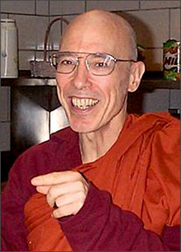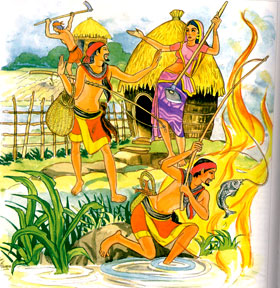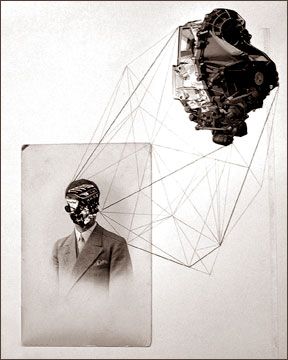|
Buddhist Spectrum
A challenge to Buddhists
Ven. Bhikkhu Bodhi
|

Ven. Bhikkhu Bodhi |
Each morning, I check out a number of Internet news reports and
commentaries on websites ranging from the BBC to Trutbout. Reading about
current events strongly reinforces for me the acuity of the Buddha’s
words: “The world is grounded upon suffering.”
Almost daily I am awed by the enormity of the suffering that assails
human beings on every continent, and even more so by the hard truth that
so much of this suffering springs not from the vicissitudes of
impersonal nature but from the fires of greed, hatred, and delusion
raging in the human heart.
Seeing the immensity of the world’s anguish has raised in my mind
questions about the future prospects for Buddhism in the West. I’ve been
struck by how seldom the theme of global suffering - the palpable
suffering of real human beings - is thematically explored in the
Buddhist journals and teachings with which I am acquainted.
It seems to me that we Western Buddhists tend to dwell in a cognitive
space that defines the first noble truth largely against the background
of our middle-class lifestyles: as the gnawing of discontent; the ennui
of over-satiation; the pain of unfulfilling relationships; or, with a
bow to Buddhist theory, as bondage to the round of rebirths.
Too often, I feel, our focus on these aspects of dukkha has made us
oblivious to the vast, catastrophic suffering that daily overwhelms
three-fourths of the world’s population.
An exception to this tendency may be found with the Engaged Buddhist
movement. I believe this is a face of Buddhism that has great promise,
but from my superficial readings in this area I am struck by two things.
|

Illustration by P Wickramanayaka |
First, while some Engaged Buddhist seek fresh perspectives from the
Dharma, for many Buddhism simply provides spiritual practices to use
while simultaneously espousing socio-political causes not much different
from those of the mainstream Left. Second, Engaged Buddhism still
remains tangential to the hard core of Western interest in Buddhism,
which has fastened upon the Dharma principally as a path to inner peace
and self-realisation.
If Buddhism in the West becomes solely a means to pursue personal
spiritual growth, I am apprehensive it may evolve in a one-sided way and
thus fulfil only half its potential. Attracting the affluent and the
educated, it will provide a congenial home for the intellectual and
cultural elite, but it risks turning the quest for enlightenment into a
private journey that, in the face of the immense suffering which daily
hounds countless human lives, can present only a resigned quietism.
It is true that Buddhist meditation practice requires seclusion and
inwardly focused depth. But, I ask myself, wouldn’t the embodiment of
Dharma in the world be more complete by also reaching out and addressing
the grinding miseries that are ailing humanity?
I know we engage in lofty meditations on kindness and compassion and
espouse beautiful ideals of love and peace. But note that we pursue them
largely as inward subjective experiences geared towards personal
transformation.
Too seldom does this type of compassion roll up its sleeves and step
into the field. Too rarely does it translate into pragmatic programs of
effective action realistically designed to diminish the actual
sufferings of those battered by natural calamities or societal
deprivation.
American Jewish World Service doesn’t aspire to convert people to
Judaism but to express Judaism’s commitment to social justice by
alleviating “poverty, hunger, and disease among the people of the
developing world regardless of race, religion, or nationality.”
Why doesn’t Buddhism have anything like that? Surely we can find a
supporting framework for this in Buddhist doctrine, ethical ideals,
archetypes, legends, and historical precedents.
I recognise that many individual Buddhists are actively engaged in
social service and that a few larger Buddhist organisations work
tirelessly to relieve human suffering around the globe. Their selfless
dedication fully deserves our appreciation. Unfortunately, however,
their appeal has as yet been limited.
Buddhist teachers often say that the most effective way we can help
protect the world is by purifying our own minds, or that before we
engage in compassionate action we must attain realization of
selflessness or emptiness.
There may be some truth in such statements, but I think it is a
partial truth. In these critical times, we also have an obligation to
aid those immersed in the world who live on the brink of destitution and
despair.
The Buddha’s mission, the reason for his arising in the world, was to
free beings from suffering by uprooting the evil roots of greed, hatred,
and delusion. These sinister roots don’t exist only in our own minds.
Today they have acquired a collective dimension and spread out over
whole countries and continents. To help free beings from suffering today
therefore requires that we counter the systemic embodiments of greed,
hatred, and delusion.
In each historical period, the Dharma finds new means to unfold its
potentials in ways precisely linked to that era’s distinctive historical
conditions.
I believe that our own era provides the appropriate historical stage
for the transcendent truth of the Dharma to bend back upon the world and
engage human suffering at multiple levels - even the lowest, harshest,
and most degrading levels - not in mere contemplation but in effective,
relief-granting action illuminated by its own world transcending goal.
A special challenge facing Buddhism in our age is to stand up as an
advocate for justice in the world, a voice of conscience for those
victims of social, economic, and political injustice who cannot stand up
and speak for themselves.
This, in my view, is a deeply moral challenge marking a watershed in
the modern expression of Buddhism. I believe it also points in a
direction that Buddhism should take if it is to share in the Buddha’s
ongoing mission to humanity.
Abhidhamma in a nutshell - xv:
Evil thoughts
Shamika SOYSA
 Recall the third episode titled ‘When committing evil acts’ and the
story of ‘Bruce’. Eight types of Consciousness rooted in Attachment (Lobha
Mulika Chiththas) were explained at first in that episode. In addition
to other Chethasikas which were featured in common, following three
Chethasikas are particular to Lobha Mulika Chiththas. They are together
bundled as Lobha Thrikaya. Recall the third episode titled ‘When committing evil acts’ and the
story of ‘Bruce’. Eight types of Consciousness rooted in Attachment (Lobha
Mulika Chiththas) were explained at first in that episode. In addition
to other Chethasikas which were featured in common, following three
Chethasikas are particular to Lobha Mulika Chiththas. They are together
bundled as Lobha Thrikaya.
(5) Lobha - Attachment
Similar explanation could be given as in the third episode. Lobha or
attachment is the likeness, lust, greed or passion for beautiful,
attractive or desirable sensual objects. This Chethasika is contained in
all eight types of Lobha Mulika Chiththas.
(6) Ditthi - False view
Impression that there is no sin and merit, no results of bad kamma,
nothing wrong with doing any evil act to accomplish one’s mission is a
‘False View’. ‘Ditthi’ refers to this false view. In expansion this is
the Michcha Ditthi. This Chethasika is contained in four of the
Ditthigatha Samprayuktha Lobha Mulika Chiththas.
(7) Mana - Conceit
This is the mental state of thinking that self is more supreme than
another (Seiya Mana), equal to another (Sadhisa Mana) or minor than
another (Heena Mana) based on undue facts. For example, Dewadatta
equalised himself with the Buddha as he was his brother-in-law. He tried
to become the Buddha by killing him just as Ajasattha became King by
killing his father. This is also an immoral mental state and contain in
four of the Ditthigatha Viprayuktha Lobha Mulika Chiththas.
The next four Chethasikas bundled by the name ‘Dwesha Chathushkaya’
particularly contain in two of the Consciousness rooted in ill-will or
aversion (Dwesha Mulika Chiththas).
(8) Dosha - Hatred
This is simply the anger, hatred, ill-will or aversion which arises
with a Dwesha Mulika Chiththas. There it was named as Patigha.
(9) Issa - Jealousy
This is the mental state of jealousy. It is the characteristic of
envying others prosperity and success. It is the incapability of bearing
others being treated reasonably. Obviously jealousy is connected with
hatred so are contained in Dwesha Mulika Chiththas.
(10) Machchariya - Avarice
This is the concealment of one’s own property. It is the dislikeness
of others knowing that oneself has wealth or property. Mattakundali’s
story is the best example for this feature. When Dwesha Mulika Chiththas
arise due to a reason of this nature, Machchariya Chethasika is present.
(11) Kukkuchcha - Worry
This is one of the hindrances taken together with Uddhachcha. This is
the remorse over committed evil and good that is not done. Its chief
characteristic is grieving and repenting over these two situations.
The next two Chethasikas are mentioned together in many texts.
However, in Abhidhamma they are two Chethasikas usually arise together.
These two are also together taken as one of the hindrances. These two
may arise in five of the prompted or Sasankharika Chiththas out of 12
types of Akusala Chiththas.
(12) Thina - Sloth
This is the shrinking state or laziness of mind. It pulls from back
of mind engaging in work. It is opposed to the effort or Viriya
Chethasika. It is the sickness of the mind.
(13) Midhdha - Torpor
As Thina is the sickness of mind, Middha is the sickness of mental
factors. It is the gloomy state or laziness of mental states. Yet again
it drags one of doing any work and opposed to the effort.
(14) Vichikichcha - Doubt
Vichikichcha is the mental state that it is incapable of deciding
that it is as such. This is again one of the Five Hindrances and
commonly known as the doubt about eight places such as Buddha and Dhamma.
Thus ends 14 types of Immoral Mental States. It should be mentioned
again that the above explanation of these Chethasikas are very simply
done to lay a foundation on basics of Abhidhamma. One who wishes to
learn in depth is advised to read advanced Abhidhamma Books.
Reference:
A Manual of Abhidhamma by Narada Maha Thera
[email protected]
The Buddhist Column:
Simple language communication
Sachitra Mahendra
The most effective way of conveying a message is communicating in a
simple language as far as possible. This applies in writing, but not
always on Buddhist communication.
A good number of Buddhist Suttas are now being simplified and
published. Simplification simply means abridging. Abridging is commonly
seen in literature to make the youth understand the classics written in
a high-flown language. You can get an idea, but you cannot see the whole
picture in an abridged version of a work. It all depends on the author
who abridges it.
Speaking of the Dhamma, none of us are fluent or can claim for a
complete command of the philosophy. Which is quite the same with the
monks as well. If any scholar abridges a Sutta, that work can be more or
less incomplete, and may mislead the student.
The Suttas are best studied in their original form. It can be a
little hard to grasp, but read it a several times to get an idea. If you
cannot do this, that means you are not keen enough to study the
theoretical features of Dhamma. You should cultivate it.
For instance if somebody attempts to simplify Brahmajala Sutta, he
may deprive the reader of some essential features of the Sutta. The
sutta is not only about other philosophies. It has its own rhythm which
has many implications.
One can argue whether it is practical to study the Dhamma in such a
hard way. Obviously not. If one wants to get rid of the Sansara, they do
not need to read the whole Thripitaka. If they can understand and
realise the essential philosophy of the Four Noble Truths, he won’t have
to study the whole philosophy.
Our problem is that most of us know and understand what the Four
Noble Truths are. But hardly do we realise it. Simplifying the Suttas
hence will not essentially help the reader achieve what they really
need.
The Buddha used a simple language brimmed with similes as far as
possible. However there are deep features in the Dhamma which cannot be
explained in a simple language. At the same time there are instances the
simple language may help explain the deep factors. This depends on the
context.
Simplified Suttas take the Buddhism into popular region. The
philosophy can therefore be easily spread among a vast populace. However
the increase of the followers does not always mean that the philosophy
is accurate and stays on undistorted.
The unsimplified philosophy may remain confined to bookshelves, but
it is undistorted and will help out the needy. This option is rather
preferable considering the primary objectives of the Dhamma: get rid of
the Sansara.
[email protected]
The Path
Best of the paths is the eightfold,
best of the truths the four;
best of the virtues is freedom from attachment;
best of the people is the one who sees.
This is the path;
there is no other that leads to the purifying of insight.
Follow this path, and Mara will be confused.
If you follow this path, you will end your suffering.
This path was preached by me
when I became aware of the removal of the thorns.
You yourself must make the effort.
The perfected ones are only preachers.
Those who enter the path and practice meditation
are released from the bondage of Mara.
“All created things perish.”
Whoever realises this transcends pain;
this is the clear path.
“All created things are sorrow.”
Whoever realises this transcends pain;
this is the clear path.
“All forms are unreal.”
whoever realises this transcends pain;
this is the clear path.
Whoever does not rise when it is time to rise,
who, though young and strong, is lazy,
who is weak in will and thought,
that lazy and idle person will not find the path of wisdom.
Watching one’s speech, restraining well the mind,
let one not commit any wrong with one’s body.
Whoever keeps these three roads of action clear,
will make progress on the path taught by the wise.
Through meditation wisdom is gained;
through lack of meditation wisdom is lost.
Whoever knows this double path of progress and decline,
should place oneself so that wisdom will grow.
Cut down the forest of desires, not just a tree;
danger is in the forest.
When you have cut down the forest and its undergrowth,
then, mendicants, you will be free.
As long as the desire, however small,
of a man for women is not destroyed,
so long is his mind attached,
like a sucking calf is to its mother.
Cut out the love of self,
like an autumn lotus, with your hand.
Cherish the path of peace.
Nirvana has been shown by the Buddha.
“Here I shall live in the rain,
here in winter and summer.”
Thus thinks the fool, not thinking of death.
Death comes and carries off that person
who is satisfied with one’s children and flocks,
whose mind is distracted,
like a flood carries off a sleeping village.
Sons are no help, nor a father, nor relations;
for one who is seized by death, there is no safety in family.
Understanding the meaning of this, the wise and just person
should quickly clear the path that leads to nirvana.
|

